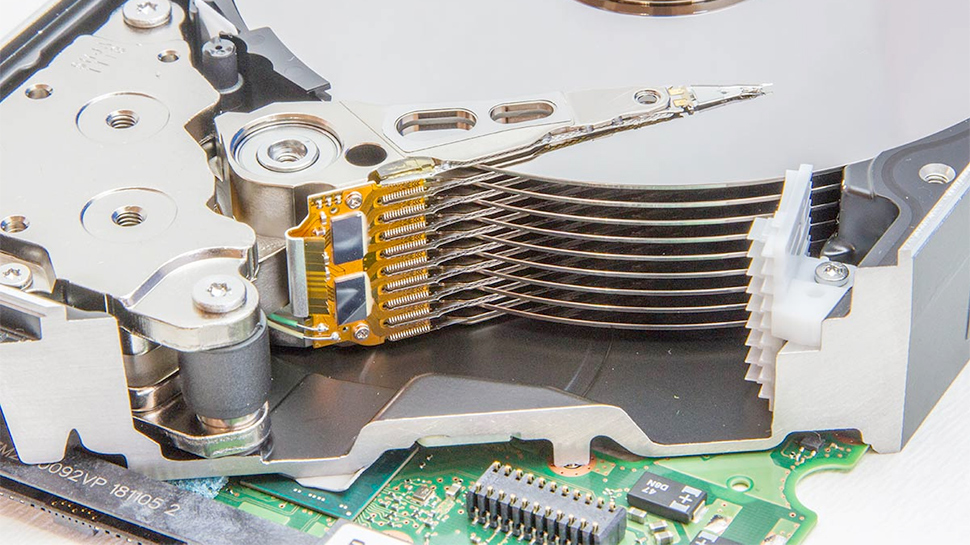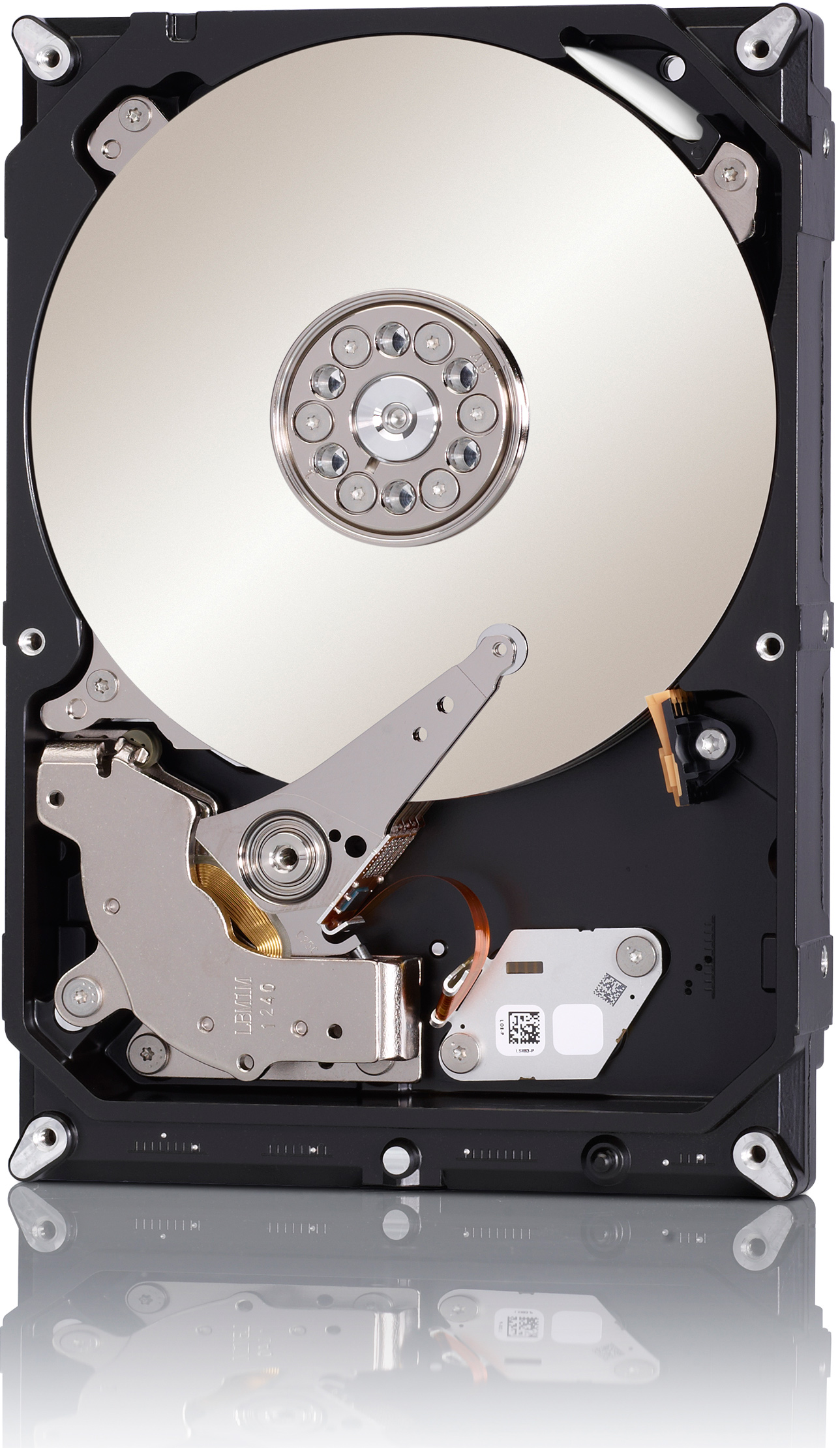HDD Makers Speed Up Development of Higher-Capacity Drives: More Disks, HAMR, MAMR
24 TB HDDs may become available in 2022, analysts believe

Demand for higher-capacity nearline hard drives require HDD manufacturers to adopt new magnetic recording technologies every several years. In addition to new recording and reading technologies, there are other ways to increase capacity of a hard disk drive. One of them is to increase the number of platters inside HDDs. Toshiba was the first company to adopt a nine-platter design several years ago and these days all flagship HDDs use nine platters. According to a recent research report and a maker of substrates for platters, ten-platter designs are not that far away. (Via StorageNewsletter, Hoya)
Later this year Seagate will release its first hard drives that use heat-assisted magnetic recording (HAMR) technology that will enable the company to build HDDs featuring capacities of up to 50 TB several years down the road. The transition to HAMR will require Seagate to adopt new heads as well as new glass platters featuring a new magnetic layer. The first HAMR HDDs will continue to feature a nine-platter design, but since glass platters are thinner than aluminum platters used today, their usage will open doors to ten-platter designs.
Analysts from Trendfocus, a company that tracks market of storage devices, recently said that HDD makers requested substrate samples with less than 0.5 mm in thickness as they explore hard drive platforms featuring 10, 11, 12 and even more platters. The market observers believe that 10-platter HDDs will become available earlier than anticipated.
Usage of more platters per 3.5-inch HDD will enable manufacturers to increase capacity of their products even if evolution of magnetic recording technology proceeds slower than expected today. For example, 10 2-TB perpendicular magnetic recording (PMR) platters allow manufacturers to build 20 TB HDDs without using HAMR or SMR. Meanwhile, it is highly likely that HDD makers will use both ten-platter designs and new energy-assisted magnetic recording technologies to maximize capacities of their drives.

Hoya, a maker of glass substrates for HDD platters recently said that it was moving forward with development of discs both for HAMR and multi-layer designs. In the past, Hoya already demonstrated prototypes of hard drives with more than ten platters, but since Hoya only develops and makes substrates, it depends entirely on HDD makers when such drives hit the market.
“We are moving forward with both HAMR development and multi-layer programs,” a statement by Hoya reads. “At present, one company is using our glass substrates. However, we expect a shift to HAMR in the future to improve recording density. This will require heat resistance necessitating a shift to glass. A market turn toward increasing capacity through increased area will require a shift to more layers, making glass substrates the superior choice for thinner layers. We have seen no changes among our customers with respect to these scenarios.”
It is noteworthy that since microwave-assisted magnetic recording (MAMR) technology does not require a mandatory shift to new platters (and therefore glass substrates) it remains to be seen whether MAMR hard drives will actually switch to thinner disks and designs with more than nine platters any time soon.
Get Tom's Hardware's best news and in-depth reviews, straight to your inbox.
Analysts from Trendfocus believe that as demand for high-capacity nearline HDDs is increasing and the competition intensifies, the first commercial hard drives featuring a 24 TB capacity will be commercially available sometime in 2022. Whether or not these drives feature 10 disks and/or HAMR or MAMR technology depends on design choices by companies like Seagate, Toshiba, and Western Digital.

Anton Shilov is a contributing writer at Tom’s Hardware. Over the past couple of decades, he has covered everything from CPUs and GPUs to supercomputers and from modern process technologies and latest fab tools to high-tech industry trends.
-
COLGeek Reply
I see what you did there...tummybunny said:It's HAMR time.
T_wS0Kw6k9cView: https://www.youtube.com/watch?v=T_wS0Kw6k9c -
Avro Arrow And to think that some people were saying that the HDD is dead. I knew very well that it wasn't because sure, SSDs far WAY faster but they don't have the same capacity as the HDD while still being somewhat affordable. Also, if you accidentally delete something from an SSD, there's no getting it back. With an HDD, you can use a program like recuva to bring it back (if you move quickly enough).Reply
Magnetic drives will always be useful for things that don't require insane speeds like documents, audio, video, mass data storage and system backups. Hell, you can get 8TB EXTERNAL drives from Costco for under $200. They're not high-speed drives but these days, even a 7200RPM drive gets toasted by a cheap SSD so there's not much point in getting them anymore. The biggest benefit from magnetic storage is no longer speed, it's capacity so forget about the speed and just get the capacity. -
Kamen Rider Blade We need to demand Multi-Actuator technology from ALL the HDD companies.Reply
Imagine 2x, 3x, 4x, actuators running in parallel, reading data at super high speeds like a mini internalized RAID per drive.
You'd actually multiply the Sequential R/W throughput and improve Random IO over night for very little cost.
Seagate even stated that Dual/Multi-Actuator had only 1 platter penalty to implement, but it doubled the speed.
That's a big deal when Single Actuator HDD's have barely touched the 300 MBps Throughput of SATA 2.0 at peak burst speeds.
I can envision a day when we have 11 Platters and 2x-4x actuators hitting 600-1200 MBps. That's going to be glorious for Sequential R/W throughput. -
vinay2070 Reply
The chances are high they may develop bad sectors much sooner than later. Twice the actuators, 2 times the chances by head accidentaly touching the disk surface?Kamen Rider Blade said:We need to demand Multi-Actuator technology from ALL the HDD companies.
Imagine 2x, 3x, 4x, actuators running in parallel, reading data at super high speeds like a mini internalized RAID per drive.
You'd actually multiply the Sequential R/W throughput and improve Random IO over night for very little cost.
Seagate even stated that Dual/Multi-Actuator had only 1 platter penalty to implement, but it doubled the speed.
That's a big deal when Single Actuator HDD's have barely touched the 300 MBps Throughput of SATA 2.0 at peak burst speeds.
I can envision a day when we have 11 Platters and 2x-4x actuators hitting 600-1200 MBps. That's going to be glorious for Sequential R/W throughput.